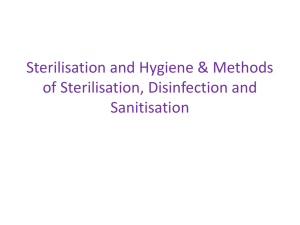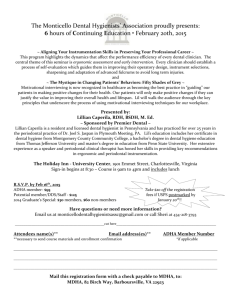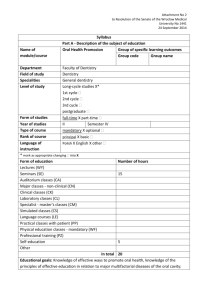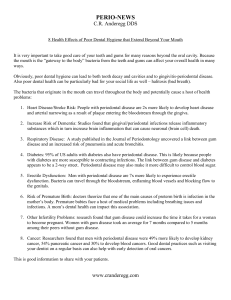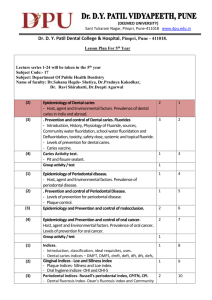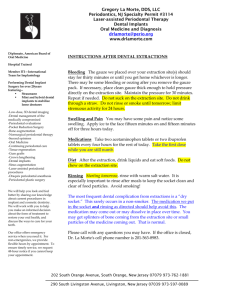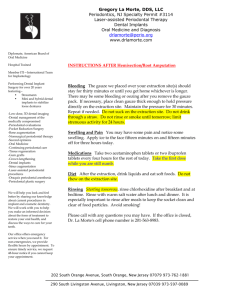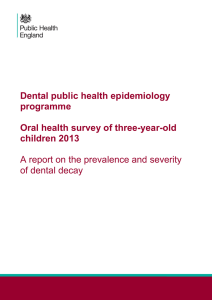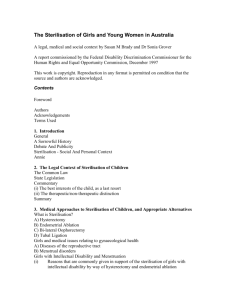Dental Nursing Exam Support: Cross Infection & Treatment
advertisement
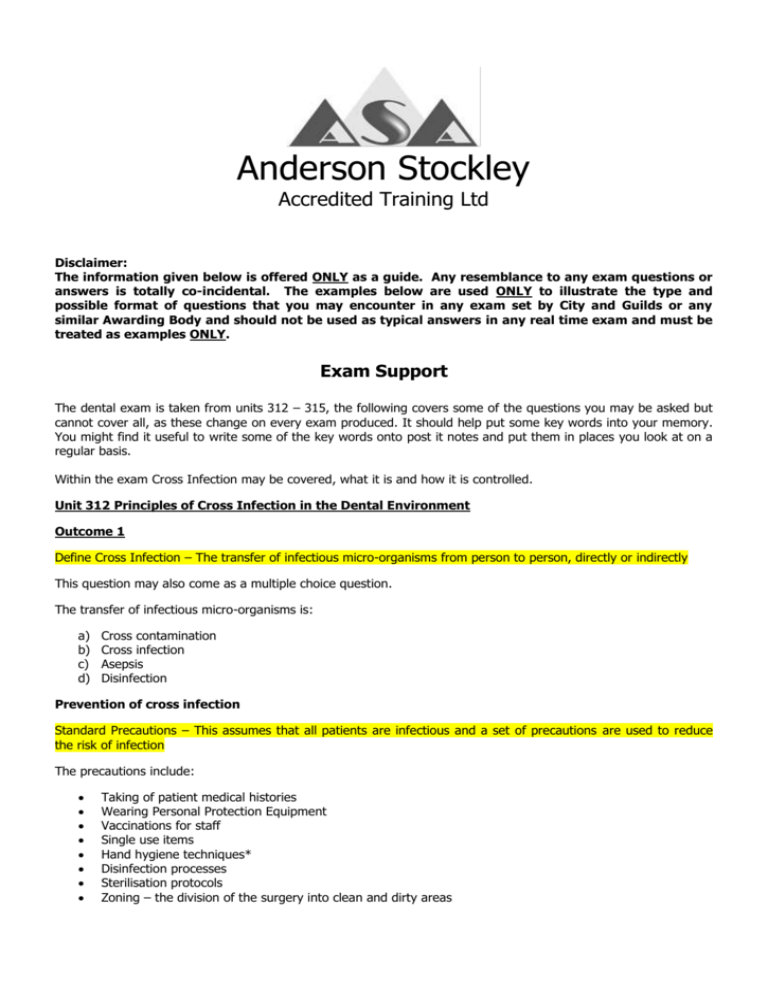
Anderson Stockley Accredited Training Ltd Disclaimer: The information given below is offered ONLY as a guide. Any resemblance to any exam questions or answers is totally co-incidental. The examples below are used ONLY to illustrate the type and possible format of questions that you may encounter in any exam set by City and Guilds or any similar Awarding Body and should not be used as typical answers in any real time exam and must be treated as examples ONLY. Exam Support The dental exam is taken from units 312 – 315, the following covers some of the questions you may be asked but cannot cover all, as these change on every exam produced. It should help put some key words into your memory. You might find it useful to write some of the key words onto post it notes and put them in places you look at on a regular basis. Within the exam Cross Infection may be covered, what it is and how it is controlled. Unit 312 Principles of Cross Infection in the Dental Environment Outcome 1 Define Cross Infection – The transfer of infectious micro-organisms from person to person, directly or indirectly This question may also come as a multiple choice question. The transfer of infectious micro-organisms is: a) b) c) d) Cross contamination Cross infection Asepsis Disinfection Prevention of cross infection Standard Precautions – This assumes that all patients are infectious and a set of precautions are used to reduce the risk of infection The precautions include: Taking of patient medical histories Wearing Personal Protection Equipment Vaccinations for staff Single use items Hand hygiene techniques* Disinfection processes Sterilisation protocols Zoning – the division of the surgery into clean and dirty areas Hand hygiene techniques are part of the standard precautions, this includes: Social – What we do day to day (at home etc.) Clinical – Hand washing techniques in the surgery. Aseptic – Surgical hand washing techniques- the solution for achieving this is Chlorhexadine (Hibiscrub, but NOT to be used as it is a trade name). Asepsis – Definition – The elimination of all *pathogenic micro- organisms. Pathogen – A disease carrying micro-organism. Non-pathogen A non-disease carrying micro-organism. Outcome 2 Micro-Organisms – Types/groups of micro-organisms: BACTERIA, FUNGI, VIRUSES, SPORES The exam may ask for types or groups of infectious micro-organism. The above may help. Examples may also be asked for, those infectious micro-organisms found in the oral cavity, try to at least, recall one of the following: Micro-organism Example Outcome Bacteria – Streptococcus Mutans Caries Streptococcus Sanguis Caries Lactobacillus Caries Porphyromonas gingivalis Gingivitus Fungi - Candida Albicans Denture Stomatitus/Oral Thrush Virus - Hepatitus B Effects liver function Herpes simplex Mouth ulcers HIV Immune difficiency Routes of entry – Direct – by way of bodily fluids, Indirect – Dirty instruments, not using disinfection techniques etc. key term aerosol. Outcome 3 This is the area of those infectious conditions which affect us and how important vaccinations are for reducing risk and how to prevent cross infection. Outcome 4 This unit covers the area of decontamination and questions on disinfection, sterilisation and the decontaminants and their uses, these may be covered in the exam. Disinfection - The destruction of some bacteria, viruses and fungi. Disinfection is by way of the use of decontaminants, these include: Sodium Hypochlorite -(bleach) used as a solution to disinfect alginate impressions 10% solution for 10 minutes. Chlorhexadine – (Corsodyl) Used as irrigation during root canal treatment. Isopropyl/Isopropanol/Ethanol- (Alcohol based) Used in wiping and transporting x-ray films. Aldehydes - Used in general sprays. All of the above except Sodium Hypochlorite may be used to clean metals and materials (chair). Sterilisation – The destruction of bacteria, viruses, fungi and spores. These may be questions on Autoclaves and the process of sterilisation. There are two types of autoclave: Vacuum (S class/B Class) – instruments can be pre - packaged and then stored for 60 days. Non-vacuum (N class) - instruments cannot be pre - packed and stored for 21 days. The temperature that the autoclave needs to attain for sterilisation is 134 degrees held, for 3 minutes at a pressure of 2.2 bar. Ultra sonic scalers need to be tested weekly for proteins. Industrial Sterilisation – uses Gamma radiation to achieve ASEPSIS. Items which have been through industrial sterilisation are single use and will pierce the flesh, for example: Sutures, Suture needles, LA needles, some endo rotary files, scalpel blades, Syringes. Outcome 5 This unit covers all of the procedures to do with Health and Safety ranging from the wearing of PPE, COSHH, RIDDOR, Waste management the disposal and separation of waste. COSHH Control of Substances Hazardous to Health – e.g. amalgam, developing solutions RIDDOR Reporting of injuries, diseases, dangerous occurrences regulations to do with inoculation injuries (sharps) Waste Management regulations – determine the disposal of waste, for us this is the separation of waste, hazardous, special and general. For example: Clinical (patients disposable bibs, cotton wool rolls, patients rinsing cups, gauze, aspirator tips, cleaning cloths, wipes. Special/Hazardous – Sharps, amalgam, spent developer and fixer fluids, lead. General – Packaging. CQC – Running water lines to reduce risk of infection from Legionalla. To be run for 2 minutes morning and evening and for 20 – 30 seconds after every patient. Unit 313 Assessment of oral health and treatment planning Outcome 1 Most of this outcome covers methods of assessment from recording of BPE, use of study models, radiographs etc. Your workbook 2 covers the coding for BPE. You might be asked to describe one of the codes e.g. code 2 pocket depth less than 3mm coloured area still visible etc. Probe used in BPE assessment CPITN probe (community periodontal index of treatment needs). How are study models used - To check bite in orthodontics, before and after treatment. How are photographs used – Before and after treatment, palatal lesions. How are radiographs used – to detect caries, bone loss, infection, occlusions. What is used for taking bite/occlusion registrations – pink wax, red soft red. Vitality testing – uses cold (ethyl chloride) or heat (Gutta Percha) Standards and Legislation The legislation relating to patient confidentiality is Data Protection Act 1998. You should familiarise yourself with the GDC Standards for dental nurses. The key ones are: Put patients interests first and act to protect them – This covers the patients right to complain, respect choices. Treat patients with dignity and respect – Don’t discriminate, be polite, treat people equally Consent There three types of consent, written, verbal, and implied (when they just sit down). Outcome 2 The most common questions may be about the difference between overjet and overbite and the most common Malocclusion. Malocclusion means ‘bad bite’. The occlusion is measured by the way the molars come together. In a class 1 the lower 6 sits slightly forward of the upper and the lower 3 is slightly forward. In a class 2 the lower 6 is behind the upper 6 and the upper 3 is behind the lower 3. There are two divisions Class 2 division 1 is recognised by protruding upper incisors. Class 2 division 2 is recognised by a very deep bite where the upper incisors are almost biting into the gum of the lower incisors (I doubt you’ll get asked about this one as it’s not so common. Class 3 is where the lower 6 is in front of the upper molars almost biting on the 5’s The bite is reversed with the lower incisors going forward of the upper (bulldog bite) This called reversed or negative overjet. Overjet – This is the horizontal distance between the upper and lower incisors. Anything greater than 3mm is where the malocclusion becomes a Class 2 division 1. Overbite – This is the vertical distance between the upper and lower incisors. Anything greater than 50% overbite of the upper over the lower is a Class 2 division 2 You may be asked the following: Proclined upper incisors are typically found in: a. b. c. d. Class Class Class Class 3 2 division 1 1 2 division 2 You may be asked questions about the care for the appliances: Removable only to be taken out for cleaning Adams cribs hold the removable appliance in place Springs or retractors move the teeth in a removable appliance Fixed braces need to be kept clean using toothbrush, interdental brushes, superfloss, mouthwash etc. Breakages need to be reported immediately Keep appointments Stay clear of sticky and hard foods or those which can colour the brace e.g. curries Teeth can only be rotated by a fixed appliance. A functional appliance uses the forces of the muscles to move the jaw. They are used in extreme cases of a Class 2 division 1 malocclusion. Outcome 3 This area will may cover the diseases of the soft tissues inside the mouth (oral mucosa) and are typically represented in the exam as questions assessing oral cancer, the most common being a squamous cell carcinoma, herpes (cold sores). There may be questions of aging which would refer to reduction of saliva, gum recession and higher risk of gingivitis. Outcome 4 Questions relating to medical emergencies may range from being able to identify which drugs are used in different situations, for example: Glyceryltrinitrate (GTN spray) – Angina Asprin – Cardiac arrest Salbutamol – Asthma Adrenaline – Allergic reaction Other questions may refer how to deal with somebody suffering from an emergency for example how to deal with someone who has fainted, seizure/fit. How to conduct a scene survey using DRSABC Outcome 5 Questions relating to dental anatomy are generally limited to one or two. These may cover: Eruption dates Function of saliva and the three pairs salivary glands The anatomy of the tooth including the cells which create: enamel (ameloblasts), dentine (odontoblasts), the structure which supports the tooth (periodontal ligament), the compact bone (lamina dura), the bone of the jaw(alveolar bone). Muscles of mastication - temporalis and masseter Main nerve to supply to the face – trigeminal nerve Unit 314 Dental Radiography Please refer to workbook 3 to help with revision of the legislation and the role of the dental nurse. Consider looking at: IRMER (Ionising Radiation Medical Environment Regulations) 2000 and the nurses role. Local Rules and what they may contain. RPS = Radiation Protection Supervisor – needs to be appointed wherever x-rays are being taken. RPA = Radiation Protection Advisor – monitors and audits quality systems. How we achieve ALARA/ALARP – having cassettes which contain intensifying screens, which fluoresce and intensify the radiation so the dose being given can be reduced. Using quality recording systems so we can identify any issues with processing. Using ‘fast films’, digital imaging (its advantages being it greatly reduces errors due to processing). Film views - Intra orals – Bitewings Periapical Occlusals Extra orals – OPG, Lateral obliques (used for identifying unerupted posterior teeth), cephalostats (used to measure angles of teeth and the jaw for orthodontics). Processing – This may look at processing errors such as dark films due to over developing, over exposure, temperature too high in the developing tank. The opposite of these processes will result in a light film. The dip order in manual processing – developer – wash- fix- wash. The deposits left in the bottom of the developer tank is silver bromide Images can then be viewed by storing in plastic display envelopes, or saved on the computer for viewing, mounted on hanger ‘pip to clip’. Quality process A quality process includes the recording of the x-ray such as labelling using patients name and date of birth, along with the date the x-ray has been taken The films are then scored according to the image: 1 2 3 Acceptable Acceptable but with some errors Unacceptable Unit 315 Scientific principles in the management of oral health diseases and dental procedures This unit relates to everything involved in treatments from the cause of caries and periodontal conditions, some instruments and equipment used. Consider looking at how caries are formed, this may be the repeating of the bacteria section given at the beginning of this document. Similarly the treatments for periodontal identifying the characteristics of a ‘true’ and ‘false’ pocket. False pockets are typically found in gingivitis and can be treated through a good oral hygiene programme. True pockets are where the periodontal ligament has been compromised and bone loss has occurred (furcation). Types of instruments for treating supragingival and subgingival periodontal disease: Supragingival – instruments with the word ‘scaler’ e.g. hand scaler, push scaler, Jacquette scaler Subgingival – instruments with the word ‘hoe’ or ‘curette’ e.g. periodontal hoe, Gracey’s curette. These go below the gum level to clean the roots. Sometime a question will already give you an answer, but will actually want you to recognise what the question is. If the question contains an answer which refers to ‘a good oral hygiene programme’ a possible answer could be: Contributors to gum disease and caries – smoking, alcohol, diabetes, pregnancy Materials – The advantage of Glass Ionomer is that it contains fluoride and promotes secondary dentine, but it does not react well with water and requires a varnish to finish it Extirpation – the removal of the pulp during RCT using a barbed broach Obturation – the filling of the canal during RCT using GP points Classes of cavity 1 2 3 4 Single cavity in a molar or pre-molar Cavity over two or three surfaces DO/MO/ MOD (will need a siqueveland matrix band) Distal or mesial cavity on an incisor Cervical cavity of incisor Local and regional anaesthesia Topical – applied to the area normally prior to the injection Intrapulpal – Injected into the pulp Intraoesus – Injected into the bone sometime by drilling into the bone Intraligamentory – Injected into the periodontal ligament Nerve block – the anaesthesia of an a group of nerves Infiltration – the anaesthesia of a specific area in particular one tooth Fluoride application Topical – applied directly to the tooth such as toothpaste, mouthwash, varnish Systemic – ingested via water or tablets or drops Dental aids – toothpaste, interdental brushes, floss, tape, disclosing tablets. Replacement of permanent teeth The questions may relate to the options to replace teeth such as, dentures, implants, bridges and the instructions for the care of them e.g. What can be used to keep a bridge clean Instructions for the care of dentures How a bridge is made up and type e.g. Maryland, pontic, abutments, retainers, wings etc. Disclaimer: The information given above is offered ONLY as a guide. Any resemblance to any exam questions or answers is totally co-incidental. The examples above are used ONLY to illustrate the type and possible format of questions that you may encounter in any exam set by City and Guilds or any similar Awarding Body and should not be used as typical answers in any real time exam and must be treated as examples ONLY.


